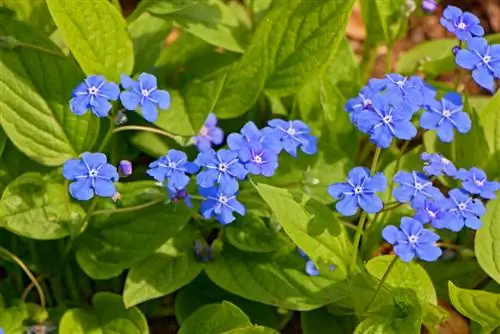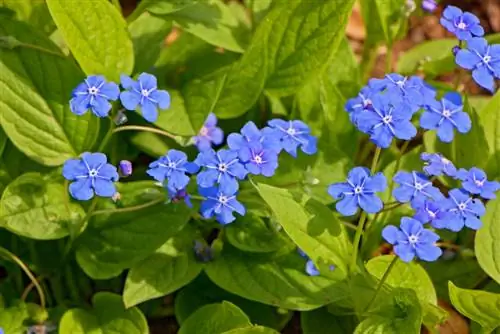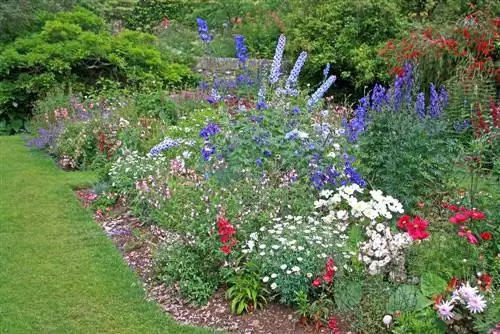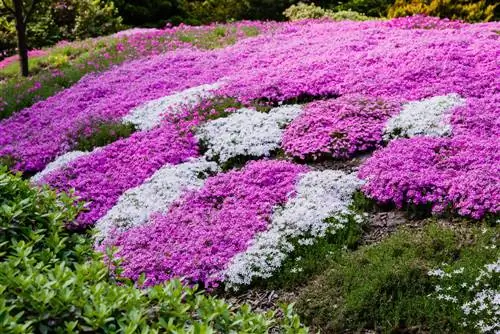- Author admin [email protected].
- Public 2023-12-16 16:46.
- Last modified 2025-01-23 11:22.
Read a commented memorial profile here with information on growth, flowering time and use. You can find out how to properly plant and care for spring navel nuts as ground cover here.

How do you maintain a memorial?
The memorial plant (Omphalodes verna) is an easy-care, ground-covering perennial that delights with delicate, sky-blue flowers in spring. It thrives best in semi-shady to shady locations, preferably under trees or on the edge of trees, in fresh, moist, humus-rich and permeable soil.
Profile
- Scientific name: Omphalodes verna
- Family: Boraginaceae
- Synonyms: Spring Umbilical Nut
- Occurrence: Europe
- Growth type: Perennial
- Growth height: 5 cm to 20 cm
- Flower: grape-like
- Leaf: egg-shaped
- Fruit: Claus Fruit
- Roots: taproot with runners
- Winter hardiness: hardy
- Use: ground cover, planter
Growth
Gedenkemein is a native perennial from the roughleaf family that unfolds its picturesque leaf and flower decorations in light shade. Originally native to the forests of southern Europe, the natural beauty has long been considered naturalized in Germany and Austria. Other names for the historical plant species are spring umbilical nuts, spring memorial or large flower memorial. Hobby gardeners appreciate Omphalodes verna as an easy-care ground cover with these growth characteristics:
- Growth type: perennial, herbaceous flowering plant, cushion-like, creeping, forms above-ground runners.
- Growth height: 5 cm to 20 cm, rarely up to 30 cm during the flowering period.
- Growth width: 20 cm to 30 cm.
- Special feature: Spring bloomers with delicate, forget-me-not-like inflorescences.
- Gardenically interesting properties: moves in in winter, overwinters as a frost-resistant root ball, undemanding, tolerates root pressure and cutting, non-toxic.
Bloom
In spring, lovely, delicate flowers tower over the ground-covering foliage of Memorial. These properties are characteristic of the umbilical nut flower:
- Inflorescence: loose racemose, few branches with 10 to 20 individual flowers.
- Single flower: five-petaled, plate-shaped, 10 mm to 15 mm in diameter.
- Flower color: sky blue to bright blue with white eye.
- Flowering time: April and May
Withered flowers turn into inconspicuous hermit fruits, each with four lonely chambers.
Leaf
Decorative leaves serve as a green backdrop for the sky-blue flowers. You can easily recognize a memorial leaf by these features:
- Leaf shape: long-stemmed, broadly ovate, pointed, 4 cm to 15 cm long.
- Texture: wrinkled
- Leaf color: green
After the flowering period, the leaves last until well into autumn. Only after the first frost do the leaves move in without any significant autumn color.
Usage
The focus of the use of memorial is its function as a ground cover in semi-shady to shady locations. Spring navel nuts also add decorative accents on the balcony. This overview shows where the distinctive perennial likes to be an eye-catcher:
| Garden | Plant idea | Balcony | Plant idea |
|---|---|---|---|
| Groundcover | Carpet of flowers under deciduous trees | Pot | Eye-catcher on the north balcony |
| Underplanting | at the feet of clematis | Bucket | Underplanting privacy shrubs |
| wooded edge | Colour accent along the privacy hedge | Balcony box | beautiful in a partially shaded flower box |
| Natural Garden | Planting strips as bee pasture | Flower staircase | blue flowers on the lowest step |
| Shadowbed | associated with shade perennials | Hanging Basket | as a hanging plant on peat moss |
| Cemetery | Tuff on a shady resting place | Europallet | trendy wall greening |
The following video shows how memorials fit harmoniously into the shady perennial bed:
Video: Beautiful flowers in the shade bed with a memorial
Plant a memorial
You can buy Memorial as a ready-to-plant perennial in specialist shops for a price of 4 to 5 euros. You can find out when, where and how to plant Omphalodes verna correctly here:
Planting time
Nurseries and garden centers offer memorials as potted goods. This has the advantage that you can plant the perennial at any time between spring and autumn. The best time to plant is in August and September. If October brings us a sun-drenched Indian summer, the window for planting remains open until the beginning of November.
Location
As a shade flowerer, Memorial wants these conditions in the bed and on the balcony:
- Partially shaded to shady location, preferably under trees or on the edge of trees.
- Fresh, moist soil, permeable and rich in humus.
- Ideally low in lime with a slightly acidic to neutral pH value of 6 to 7.5.
Memorial plants in the bed
Good soil preparation guarantees that the taproot and runners can establish themselves well. With the correct planting distance, the perennials do not get into each other's enclosure and quickly form a dense carpet. The best planting tips to read:
- Soak root balls: Place pot balls in a bucket with rainwater.
- Soil preparation: Dig up the bed soil, remove stones, weeds and old roots.
- Planting technology: dig a spacious pit, mix the excavation with compost soil, pot up the water-soaked perennial, plant in the middle and water.
- Planting distance: 25 cm to 30 cm, equivalent to 15 to 17 plants per m².
If you combine memorial plants with other perennials, strong runners can cause distress to the plant neighbors. In this case, curb the urge to spread with a root barrier.
Memorial plants in pots
On the balcony, memorial is ideally planted in a humus-rich potting soil without peat. Additives such as coconut soil as a peat substitute and expanded clay make the substrate structurally stable and well permeable. The inorganic expanded clay balls also serve as drainage on the bottom of the vessel. Plant the perennial just as deep in the ground as before in the purchase container. Measure the planting depth so that a watering edge remains free. Water freshly planted navel nuts thoroughly.
Excursus
Remember my forget-me-not difference
Three rough-leaved plants (Boraginaceae) delight with their sky-blue flowers. These are the most important differences: Memorial (Omphalodes verna) is a perennial, ground-covering perennial with a height of 5 to 15 cm. The flowering period of Omphalodes verna extends from April to May. In contrast, forget-me-not (Myosotis) thrives as a biennial perennial that, after overwintering, blooms as a rosette of leaves from May to July. Perennial Caucasus forget-me-not (Brunnera macrophylla) blooms at the same time as memorial, grows in a cushion shape without runners and is more than twice as large at 40 cm.
Care for my memory
In the right location, Memorial is very easy to care for. The mainstay of the simple care program is an adequate water supply. The perennial does not need to be fertilized. Division puts a stop to invasive spread and at the same time functions as vegetative propagation. Optional incision care is primarily considered for aesthetic reasons. In the planter, hardy memorial is grateful for winter protection. Read important care tips in brief:
Pouring
Freshly planted and during the flowering period, the risk of drought stress is particularly high. How to water navel nuts correctly:
- Keep it evenly moist, especially after planting and during flowering.
- In summer, water or sprinkle under the dense canopy of trees in dry conditions (even in light rain).
- Use predominantly collected rainwater or stale tap water as irrigation water.
Propagation
The easiest way to propagate memorials is by dividing them. This method also acts as rejuvenation and reduces the formation of runners. How to do it right:
- Share memorial in the spring.
- Pick off the root ball with a spade.
- Push the digging fork under the perennial and lift it out of the ground.
- Remove dead, old plant parts.
- Place the root ball on a firm surface and cut it in half.
- Plant sections at the new location and water them.
Generative propagation by sowing is possible. Sources for purchasing seeds are difficult to find. Hobby gardeners harvest the ripe hermitage fruits with the lonely chambers. The seeds are kept dry and dark until spring for cultivation on the windowsill from March or direct sowing from April.
Cutting
With withered inflorescences and shriveled leaves, Memorial is no longer a feast for the eyes in autumn. You can let the morbid fading take place or keep things tidy with a perennial pruning. Wait until all parts of the plant have completely died. During this process, nutrients are transferred from the leaves to the root ball as an energy reserve for the next shoot. Use a perennial sickle or scythe to cut the leaves at ground level.
Wintering
As a ground cover in the bed, Memorial is reliably hardy. If the perennial thrives in a plant container, the root ball is vulnerable to frost. A warm winter coat made of fleece and a wooden base prevent frost damage. Ideally, you should overwinter navel nuts as a potted plant in frost-free, dark winter quarters at temperatures around 5° Celsius.
Popular varieties
In the garden, the pure original species Omphalodes verna enjoys company from these beautiful memorial varieties:
- Alba: white-flowering variety, slow-growing, produces fewer runners, 5-10 cm growth height, 20-25 cm growth width.
- Elf Eye: magical memorial flower, blooms sky blue with a light eye, grows up to 15 cm high and 30 cm wide.
- Grandiflora: historical variety with extra large, bright blue flowers, 5-10 cm tall, up to 30 cm wide.
- Lore Götz: impresses with bright blue flowers and broad, lanceolate decorative leaves, height 15-20 cm.
The species Omphalodes cappadocica, also known as the Caucasus Memorial, fulfills the wish for a memorial without runners. The clump-forming perennial blooms from April to June with gentian blue flowers.
FAQ
Is memorial poisonous?
Gedenkemein is not poisonous. This fact makes the perennial the ideal ground cover for the family garden. This lovely spring bloomer with sky-blue flowers and distinctive foliage poses no danger to pets either.
Where can you plant memorials?
Gedenkemein is a picturesque ground cover for partially shaded to shady locations. Ideally, you should plant the undemanding perennial under trees or on the edge of the trees, where leafy crowns filter the sunlight. In the diffuse twilight, the sky-blue spring blossoms add decorative accents. Use spring navel nuts as underplanting for clematis, climbing roses, hydrangeas or privacy shrubs, as the perennial can easily tolerate root pressure.
When is the best time to plant spring navel nuts?
Spring umbilical nuts in pots can be planted from spring to autumn. The best time to plant the perennial is in late summer and autumn. In the sun-warmed garden soil, memorial can quickly take root and is prepared for the first frost.
What are good planting neighbors for memorials?
Associate memorials with other shade-tolerant perennials that know how to defend themselves against the strong runners. Recommended plant neighbors are: Hostas (Hosta), Bergenias (Bergenia), Larkspur (Corydalis), Bleeding Hearts (Lamprocapnos spectabilis) and Cowslips (Primula). Where light is in short supply, ornamental foliage plants harmonize impressively with sky-blue memorial flowers. These include purple bells (Heuchera), lady's mantle (Alchemilla) and ornamental grasses such as the white-edged Japanese sedge (Carex morrowii).






